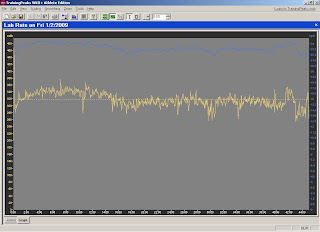Every winter I try to improve my time trial position, and every winter so far I've been able to do it. This year I lowered the bike's front end, narrowed my elbows, and moved my hands closer together. Also, in the middle of last season - since my last aero test - I replaced my front American Classic 50mm deep section wheel with a HED tri-spoke wheel and Veloflex Record 19mm tubular. I'm still using a non-dimpled Zipp 900 disc rear wheel and riding a 2001 Cervelo P2K. I test in a short-sleeved skinsuit with a Louis Garneu Rocket TT helmet and shoe covers - no gloves, no glasses. I perform the test at 25 mph entry speed and ghost pedal during the test (In case y'all are wondering why I give so much detail: this is where I'll come next winter to review my last test and prepare to do it again).

Here are my aero testing results for the past three years along with my FTP in TT position, my theoretical speed on a flat road at FTP, and my theoretical 40k TT time on a flat course at FTP. All of this assumes a Crr=0.005, a weight of 172.5 pounds for bike and rider, 80 degrees Fahrenheit, 1022 kPa air pressure, and relative humidity 50% on a calm day.
___________________________________________________
2007: CdA = 0.269 m^2 ------257 watts ------ 24.27 mph ----- 1:01:26
2008: CdA = 0.233 m^2 ------271 watts ------ 25.91 mph ----- 0:57:33
2009: CdA = 0.219 m^2 ------278 watts ------ 26.64 mph ----- 0:55:59
These drag coefficient (CdA) numbers were all developed on the same test course with the exact same testing protocol, so even if the absolute numbers are a little off -- maybe because I estimated the hill slope wrong or assumed a bad rolling resistance coefficient, Crr -- at least I know that I'm more aero than I've ever been.
The coast-down test results were amazingly repeatable. I performed 5 test runs. On the first run 4 cars passed, so I threw that one out. The times on the last four runs were 79.6 sec, 79.4 sec, 79.8 sec, and 79.6 sec.
Testing results don't guarantee race results, but the added confidence sure doesn't hurt.
If you haven't played around with aerodynamics and tested your CdA, you should - it's free speed. My improvement from 2008 to 2009, which is only 0.233-0.219=0.014 m^2, will save me 57 seconds on a 40k TT (the equivalent of 15 more average watts on a flat course). Or more realistically, about 30 seconds on the shorter TTs that I'll do. If you want to play around with the calculation spreadsheet, get it from
Badger3 and input your numbers.
Or if you're not the number crunching type, just take a piece of chalk and your TT setup to any hill that bottoms out and starts back up. Start at the top at a consistent speed. Coast down the hill and keep rolling until you stop. Mark a spot with the chalk where your front wheel stops. Do it a few times to get a good average. Then change something - your helmet, skinsuit, wheels, position, etc. and do the test again under the exact same conditions (temperature, weight, humidity, etc.) on a calm day. If you pass your prior mark on the road, you are more aero and therefore are faster (as long as your power output is the same).
 I always try to resist the temptation to play copycat, but I could not resist plagiarizing this little section from "Coppi and Me, Part II" by Padrig over at Belgium Kneewarmers.
I always try to resist the temptation to play copycat, but I could not resist plagiarizing this little section from "Coppi and Me, Part II" by Padrig over at Belgium Kneewarmers.










